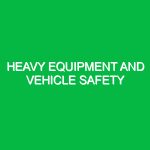Forklifts are an indispensable part of many industries, from warehouses to construction sites. However, with great utility comes significant responsibility. The safe operation of forklifts is not merely a guideline; it’s a critical aspect of workplace safety that affects both employees and the overall efficiency of operations. In this article, we will explore the importance of safe forklift operation within the Health, Safety, and Environment (HSE) framework, identify potential hazards and risks, recommend best practices, and outline the regulations that govern forklift use.
Understanding Safe Operation of Forklifts
At its core, the safe operation of forklifts entails the use of these powerful machines in a manner that minimizes risk to operators, other personnel, and the surrounding environment. This involves not only adhering to safety protocols but also fostering a culture of safety in the workplace. The relevance of safe forklift operation in HSE is profound, as improper use can lead to accidents, injuries, and even fatalities. According to the Occupational Safety and Health Administration (OSHA), forklift-related accidents account for a significant percentage of workplace injuries, highlighting the need for stringent safety measures.
Identifying Hazards and Risks
Understanding the potential hazards associated with forklift operation is crucial for creating a safe working environment. Here are some common risks linked to the use of forklifts:
1. Operator Error
Operator error is perhaps the most significant risk factor in forklift operation. This can stem from inadequate training, lack of experience, or failure to follow safety protocols. For instance, a forklift operator may inadvertently lift a load that is too heavy, leading to tipping and potential injury.
2. Poor Visibility
Forklifts often operate in crowded spaces with limited visibility. Blind spots can obscure pedestrians or other equipment, increasing the likelihood of collisions. A real-life example of this occurred in a busy warehouse where a forklift operator could not see a coworker standing behind a stack of pallets. Fortunately, the incident resulted in only minor injuries, but it could have been much worse.
3. Load Stability
Improper load handling can lead to instability, causing the load to shift or fall. Overloading a forklift or stacking items incorrectly can create an unsafe environment. This was exemplified in a case study conducted in a distribution center where an improperly balanced load caused a forklift to tip over, resulting in injuries to the operator and nearby workers.
4. Environmental Factors
Environmental conditions such as wet floors, uneven surfaces, or poor lighting can exacerbate the risks associated with forklift operation. For example, in outdoor construction sites, rain or mud can create slippery conditions that make it difficult for operators to maintain control of their machines.
5. Mechanical Failures
Forklifts, like any machinery, require regular maintenance to operate safely. Mechanical failures can occur due to wear and tear, leading to malfunctions that can endanger the operator and others nearby. A well-documented case involved a forklift that experienced brake failure due to improper maintenance, resulting in a serious accident.
Safety Precautions and Best Practices
To mitigate the risks associated with forklift operation, it is essential to implement effective safety precautions. Here are some best practices to consider:
1. Comprehensive Training
All forklift operators should undergo thorough training, which includes both theoretical knowledge and practical skills. Training programs should cover safe operating procedures, load handling techniques, and emergency response strategies. Regular refresher courses can help keep operators updated on best practices and reinforce the importance of safety.
2. Conduct Regular Inspections
Before operating a forklift, operators should conduct pre-shift inspections to identify any mechanical issues. This includes checking brakes, steering, lights, and the lifting mechanism. If any problems are detected, the forklift should be taken out of service until repairs are made. A personal anecdote from my time in a warehouse highlights this: one morning, an operator noticed a loose bolt during a pre-shift inspection, preventing what could have been a catastrophic failure during operation.
3. Maintain Clear Pathways
Ensuring clear pathways is vital for safe forklift operation. Marking pedestrian walkways and using signage can help prevent accidents. It’s essential to establish specific routes for forklifts and maintain these pathways free of obstacles. In a bustling environment, this practice fosters a more organized and safer workspace.
4. Use Proper Lifting Techniques
Operators must understand how to lift loads correctly. This includes positioning the load at the appropriate height, ensuring it is stable, and avoiding sudden movements. One key point is to always lift with the forks level to the ground to prevent tipping.
5. Implement Safety Zones
Creating safety zones around areas where forklifts operate can help protect pedestrians. These zones can be marked with cones or barriers, clearly indicating where personnel should not enter during forklift operations. This measure significantly reduces the risk of collisions between forklifts and workers.
6. Encourage Communication
Effective communication among team members is crucial. Operators should use horns or lights to signal their presence, especially in areas with limited visibility. Additionally, fostering a culture where employees feel comfortable reporting unsafe conditions or near-misses can help organizations identify potential hazards before they lead to accidents.
Regulatory Standards and Compliance
The safe operation of forklifts is governed by various regulations and standards that aim to protect workers and ensure safe practices. Here are some key regulations to be aware of:
1. OSHA Regulations
The Occupational Safety and Health Administration (OSHA) has established specific standards for forklift operation, particularly in 29 CFR 1910.178. These regulations outline training requirements, operator responsibilities, and maintenance standards. Organizations must comply with these regulations to avoid penalties and, more importantly, to protect their workforce.
2. ANSI/ITSDF Standards
The American National Standards Institute (ANSI) and the Industrial Truck Standards Development Foundation (ITSDF) have published standards (ANSI/ITSDF B56.1) that provide guidelines for the safe design and use of forklifts. These standards cover everything from the construction of forklifts to their operational safety, serving as a valuable resource for organizations looking to ensure compliance.
3. Local Regulations
In addition to federal standards, local regulations may apply. It is essential for organizations to be aware of any regional legislation governing forklift operation, as these can vary by state or municipality. Conducting regular audits to ensure compliance with all applicable laws is a responsible business practice.
Conclusion
The safe operation of forklifts is a multifaceted issue that requires a comprehensive understanding of risks, adherence to safety practices, and compliance with regulations. By implementing effective training programs, maintaining equipment, and fostering a culture of safety, organizations can significantly reduce the likelihood of accidents. The stakes are high, as the implications of neglect can lead to severe injuries, financial loss, and damage to reputations. By prioritizing safety in forklift operations, companies not only protect their employees but also enhance their operational efficiency and sustainability.
In the end, it’s about creating an environment where safety is the norm, not the exception. The safe operation of forklifts is not just a duty; it’s a commitment to ensuring that every employee returns home safely at the end of the day.


